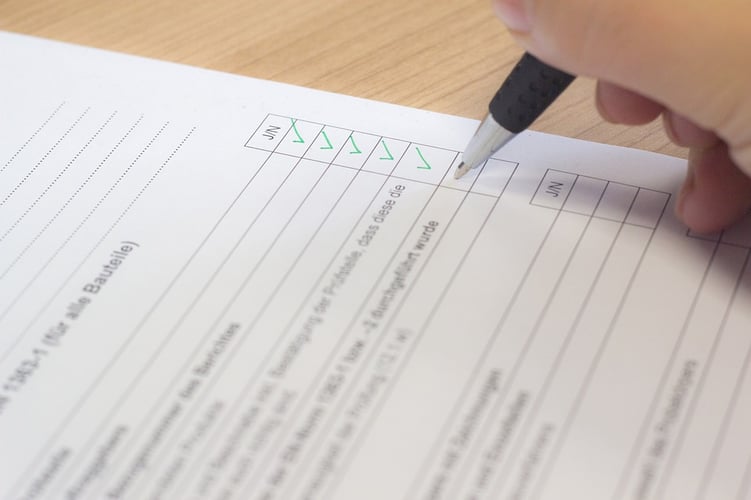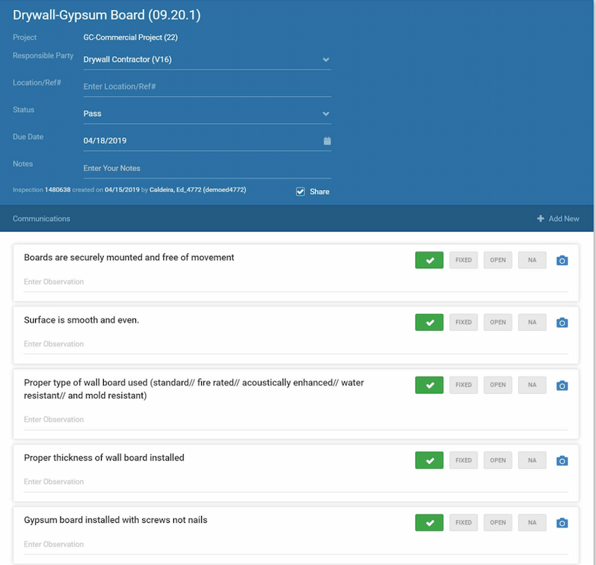
Setting up a Construction Inspection Checklist is one of the most important steps in building your quality management system. While it might seem like a daunting task at first, your experience with common issues in construction—and input from stakeholders—can help you create a strong starting point. Once your initial checklists are in place, you can continue to improve them by adding new items as they arise on the job.
Importance of Construction Checklists
Construction checklists are essential for several reasons:
- A construction checklist helps document the project's compliance with project specifications and requirements including industry, governmental, or internal standards.
- A construction inspection checklist is a great tool for proving work was completed correctly. By using a well-documented inspection checklist, a company can demonstrate that they followed due diligence at the construction site.
- The construction inspection checklist is used to train new construction field personnel as well as inspectors. A good checklist will provide an agenda for performing the inspection as well as information necessary to evaluate acceptance of the inspected work.
- The construction inspection checklist identifies construction risks. By identifying potential risks early in the process, quality and safety risks are minimized, and you can reduce environmental impacts.
- This makes it a great tool for implementing measures to reduce project risks.
This blog post will share some tips on deciding which checklists you need and the how to create any construction inspection checklist in 15 minutes.
There are five steps that we recommend.
- Foundation
- Structure
- Dry-in
- MEP
- Pre-Drywall
- Finishes
- Exterior
Another common approach is to create a checklist for each feature of work, specialty trade, or specification section. Once you have determined the areas you want to focus on, it will help streamline the process and simplify creating construction checklists.
You don’t need to create all of the project checklists on day one. Start with the one that you will be using first and build them one at a time. This allows you to get your inspection process going quickly and minimize the amount of work you need to do to get started.
Keep Your Construction Inspection Checklist Simple
The first step to creating an inspection checklist in 15 minutes is to keep it simple. You can also use a simple construction site inspection checklist template to help you hit the ground running.
For example, check out FTQ360's online sharing library that contains over 500 inspection checklists in key divisions of work.
Nothing saves you time like someone else having already done the work for you. Even if you need to create your own checklist, keeping it simple ensures you have a complete inspection checklist that can get your QA/QC inspection system started in 15 minutes.

(Image source:FTQ360 )
Start With Only Ten Checkpoints
Start with just ten safety-related checkpoints to keep your construction inspection checklist focused and manageable. This ensures your checklist is comprehensive enough for most projects while helping field personnel concentrate on the most critical safety and quality concerns.
By limiting the list to the most common trouble spots, you increase awareness and improve the chances of getting things right the first time.
Each checkpoint should be clearly worded and begin as if continuing the sentence:
“Verify that (you have)…”
Here are some examples of well-worded checkpoints:
- Scaffolding erected
- Safety netting around the work area.
- Watertight seals around conduit penetrations through exterior walls and roof
- Secure conduits to prevent movement and chafe
- Bends radius not less than the specified minimum for the conduit size
Start with the issues that are top on your mind when deciding which checkpoints should be on the form. Consider customer punch items and concerns. Think about mistakes, errors, and omissions that drive you crazy, and repairs that drive up the project cost. Naturally, you'll develop a decent shortlist that focuses on the most crucial concerns.
Benchmark With Other Companies
The next step is to benchmark with other companies that have previously created inspection checklists. Compare the lists and review which checkpoints each company has included on their list. Then, based on your unique requirements, consider adding or removing items from your list accordingly.
Refine Your Construction Inspection Checklist
The final step is to refine your construction inspection checklist. Share it with the people who will be using it and ask for their feedback. This not only helps improve the checklist, but also builds trust and increases the likelihood of successful implementation.
Next, test the checklist in the field. Use what you learn from real-world conditions to make adjustments. A well-refined checklist should be clear and simple enough for construction inspectors to use with little or no training.
While there are more advanced ways to design a checklist, don’t let the pursuit of perfection slow you down. Your goal is to create a practical, credible checklist that works effectively in the field.
Use FTQ360 Construction Site Inspection Software
You can save countless hours on your construction project by using the 500+ pre-loaded field-proven checklists in FTQ360 Construction Site Inspection Software. These are ready to use from day one, easy to customize to your own needs, and you can also import your own custom checklists created using the five steps outlined above.
In addition, FTQ360 construction site inspection software is configurable to meet any construction company's specific needs, including the ability to upload photos and videos of deficiencies for further review on a mobile device if needed.
With FTQ360 you track all defects (including non-conformances) throughout a project's lifecycle and generate reports that are easily used for quality audits, reactive root cause analysis, and continuous improvement programs t at every stage in the process. It also helps keep everyone up to date with a digital version of forms like use certificates, purchase orders, and insurance cover notes – which simplifies work processes while increasing productivity.
We hope these tips will help you create a construction inspection checklist quickly and efficiently so you can overcome the barrier of transferring from pen and paper/spreadsheets to software systems. Simpler is always better.
With FTQ360, You can put a construction checklist together in a matter of minutes, it is easier to use in the field, and keeps people focused on the most critical quality issues. Do not undermine your effort by doing more – be smart about doing less.
To get started on your construction project with FTQ360, sign up for a free demo.
Read more about Construction Inspection Checklists
The 9 Best Tips for Construction Site Inspection Checklists
Top Reasons Why Construction Inspection Checklists are Better
How to Create Quality Control Checklist Templates
Top Construction Checklist Benefits You Must Know of in 2025
